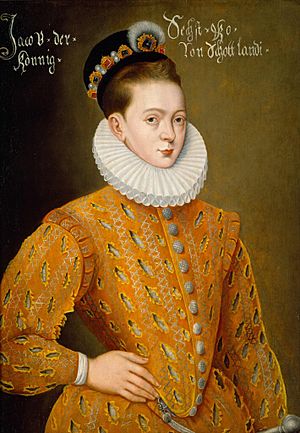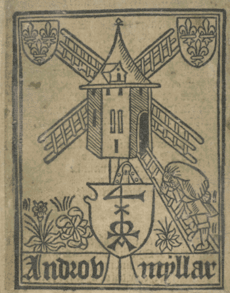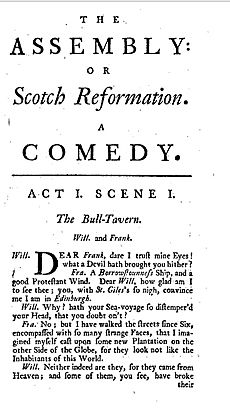Literature in early modern Scotland facts for kids
Literature in early modern Scotland means all the books, poems, and plays written in Scotland or by Scottish writers from the early 1500s to the mid-1700s. This time period is known as the Renaissance and leads up to the Enlightenment.
At the start of this period, Gaelic was becoming less common. It was mostly spoken in the Highlands and Islands. But the old tradition of Classic Gaelic Poetry still lived on. Middle Scots became the main language for both the rich and most other people. In 1507, a printing press was set up. This made it easier to share Scottish literature. It probably also helped make Scottish identity stronger.
King James IV loved poetry and supported many poets, called makars. These poets were often church leaders. One famous makar was Gavin Douglas. His book Eneados (1513) was the first full translation of a major classical story into an English-like language. King James V also supported many poets. George Buchanan started a new style of poetry written in Latin.
When Mary, Queen of Scots ruled, and later when her son James VI was young, there wasn't much support for arts. This was because there was no royal court and lots of political trouble. The Kirk (the Scottish Church) didn't like poetry unless it was about religion. But other kinds of poetry still survived.
In the 1580s and 1590s, James VI really pushed for literature in Scots. He became a supporter and friend to a group of Scottish court poets and musicians. They were later called the Castalian Band. David Lyndsay's play The Thrie Estaitis (1540) is the only complete play from before the Reformation that we still have. Buchanan was very important for theatre in other parts of Europe. But his plays were in Latin, so they didn't have a big impact in Scotland. There were a few Scottish plays, but Scotland didn't have professional acting groups or theatres like England did back then.
When James VI became king of England in 1603, the Scottish court was no longer the main place for writers to get support. James also started to prefer the English language. Some Scottish poets went with the king to London. There, they began to change their writing to be more like English. As the old Gaelic poetry style faded, a new style of everyday Gaelic poetry appeared. Often, women wrote these poems.
The Latin poetry tradition became very strong with the book Deliciae Poetarum Scotorum (1637). This time also saw the first Scottish women poets whose names we know. Elizabeth Melville's Ane Godlie Dream (1603) was the first book published by a woman in Scotland. This was also when ballads became important written poems in Scotland. From the 1600s, rich writers also started using ballads.
After Scotland and England joined together in 1707, many leaders and teachers didn't encourage the use of Scots. But Allan Ramsay started a "vernacular revival." This helped bring back interest in older Scottish literature. He also made pastoral poetry popular. His opera The Gentle Shepherd was a very important work of that time. Ramsay was part of a group of poets who wrote in both Scots and English.
Tobias Smollett was a poet, writer, and playwright. But he is most famous for his adventure novels. Many people see him as Scotland's first novelist. The early 1700s also brought new ideas to everyday Gaelic poetry. It mixed old styles with influences from the Lowlands. Scottish playwrights wrote plays in London. In Scotland, English actors performed plays. But they often had problems with the Kirk. Ramsay helped set up a small theatre in Edinburgh. But it closed soon after the 1737 Licensing Act was passed. A new theatre opened in Cannongate in 1747 and kept going without a licence into the 1760s.
Contents
Literature in the 1500s
Language and Printing
By the early 1500s, Gaelic had been shrinking for 300 years. It became a less important language, mostly spoken in the Highlands and Islands. The old style of Classic Gaelic poetry lasted longer in Scotland than in Ireland. The last skilled poet from the MacMhuirich family, who wrote poems for clan leaders, was still working in the early 1700s. However, clan leaders were less interested in paying for these special Gaelic poems.
Middle Scots slowly took over from Gaelic. It became the language of the rich and most other people. Middle Scots came mostly from Old English, but it also had Gaelic and French words. People usually called it Inglyshe. It was very similar to the language spoken in northern England. But by the 1500s, it had its own spelling and writing rules. From the mid-1500s, written Scots was more and more influenced by the English spoken in southern England. This was because of more contact between the royal families and politicians. As more books printed in England became available, most writing in Scotland started to look like English writing.
In 1507, a printing press was set up with the king's permission. This made it easier to share Scottish literature. It was probably meant to make Scottish national identity stronger. The first Scottish press was in Edinburgh. It was started by a merchant named Walter Chepman and a bookseller named Androw Myllar. This first press didn't last very long. But besides law books and religious works, it also printed books by Scottish makars before it closed around 1510. The next known press was run by Thomas Davidson. He was the first in a long line of "king's printers." He also printed works by the makars.
Famous Scottish Poets (Makars)
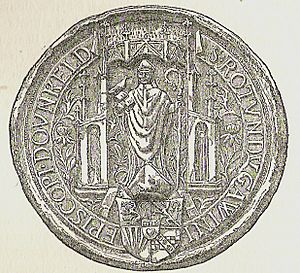
King James IV (ruled 1488–1513) created a royal court that supported poets. These court poets, or makars, were often churchmen. They included Robert Henryson (around 1450-1505). He rewrote old stories from the Middle Ages and classical times. His works include Testament of Cresseid and The Morall Fabillis. William Dunbar (1460–1513) wrote funny poems, songs, angry poems, and dream visions. He showed that the everyday language could be used for any kind of poetry.
Gavin Douglas (1475–1522) became a bishop. He brought new ideas about humanism and classical stories into his poetry. The most important work during James IV's reign was Douglas's version of Virgil's Aeneid, called the Eneados. It was the first full translation of a major classical text into an English-like language. He finished it in 1513. But the terrible defeat at the Battle of Flodden ended the king's reign and overshadowed the work.
King James V (ruled 1513–42) also supported poets and writers. He helped William Stewart and John Bellenden. They translated a Latin book, History of Scotland, into poems and prose. David Lyndsay (around 1486–1555) was a diplomat and a very busy poet. He wrote sad stories, romances, and funny, critical poems. George Buchanan (1506–82) was very important as a Latin poet. He started a tradition of new Latin poetry that continued into the 1600s.
From the 1550s, during the rule of Mary, Queen of Scots (ruled 1542–67) and when her son James VI was young (ruled 1567–1625), there wasn't much cultural activity. This was because there was no royal court and lots of political trouble. The Kirk (the Scottish Church), which was very strict, also didn't like poetry unless it was about religion.
Still, poets from this time included Richard Maitland (1496–1586). He wrote thoughtful and satirical poems like Dunbar. John Rolland (active 1530–75) wrote allegorical satires, like Douglas. And Alexander Hume (around 1556–1609), a courtier and minister, wrote nature poetry and poems sent as letters. Alexander Scott (around 1520–82/3) wrote short poems meant to be sung. This paved the way for the Castalian poets during James VI's adult rule.
Unlike many kings before him, James VI didn't like Gaelic culture. However, in the 1580s and 1590s, he strongly promoted Scottish literature written in Scots. His book, Some Rules and Cautions to be Observed and Eschewed in Scottish Prosody, was published in 1584 when he was 18. It was a guide for writing poetry and described the Scottish poetic tradition. He applied Renaissance ideas to it.
He became a supporter and member of a group of Scottish court poets and musicians. This group was later called the Castalian Band. It included William Fowler (around 1560–1612), John Stewart of Baldynneis (around 1545–1605), and Alexander Montgomerie (around 1550–98). They translated important Renaissance texts. They also wrote poems using French styles, like sonnets. These poems were about stories, nature, satire, and love. Later poets who followed this style included William Alexander (around 1567–1640) and Robert Ayton (1570–1627). By the late 1590s, the king's support for Scottish traditions lessened. This was because he might become king of England.
Scottish Plays
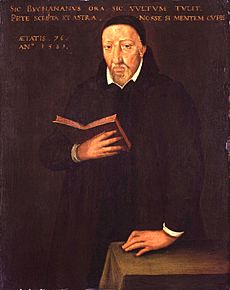
David Lyndsay put on a short play at Linlithgow Palace for the king and queen in 1540. It was probably a version of his play The Thrie Estaitis. This play made fun of corruption in the church and government. It is the only complete play from before the Reformation that still exists.
George Buchanan was very important for theatre in other parts of Europe. His plays like Jepheths and Baptistes influenced famous French playwrights. But his plays were in Latin, so they didn't have a big impact in Scotland. The Maner of the Cyring of ane Play (before 1568) and Philotus (published in London in 1603) are rare examples of plays that survived. Philotus is a funny Scottish play with mistaken identities. It was probably performed for Mary, Queen of Scots, or James VI.
James VI and his wife Anne of Denmark loved to dress up and take part in masques. These were performances at weddings that included music, dancing, and costumes. England had professional acting groups and theatres during this time, but Scotland did not. However, James VI showed his interest in plays. He arranged for an English acting company to build a playhouse and perform in 1599.
Literature in the 1600s
Poetry Changes
After James VI became king of England, he started to prefer the English language. In 1611, the Scottish Church used the English Authorised King James Version of the Bible. By 1617, people said that Scots and Englishmen could understand each other well enough. One historian said James created a "three-tier system," with Gaelic at the bottom and English at the top.
When the court moved to London in 1603, it was a big loss for Scottish literature. Many Scottish poets, like William Alexander and Robert Aytoun, went with the king to London. They kept writing, but their language quickly became more like English. James was very active in supporting English poetry and plays. This helped English literature reach its peak during his reign. But his support for Scottish writing largely faded. The only important court poet who stayed in Scotland after the king left was William Drummond of Hawthornden (1585–1649).
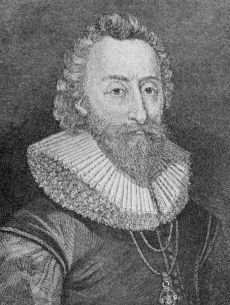
As the old style of Gaelic poetry declined, a new style of everyday Gaelic poetry began to appear. The old poetry used a language that hadn't changed much since the 1100s. But the everyday language kept developing. Unlike the old style, which used a certain number of syllables in each line, the new poets used stressed syllables. However, they still used complex metaphors and often wrote poems praising people, just like the old poets. Some of these everyday poets were women, like Mary MacLeod of Harris (around 1615–1707).
The tradition of new Latin poetry reached its best with the book Deliciae Poetarum Scotorum (1637). This book was published in Amsterdam. It contained works by the most important Scottish Latin poets since Buchanan. This period also saw the first Scottish women poets whose names we know. Elizabeth Melville's (active 1585–1630) Ane Godlie Dream (1603) was a popular religious story. It was the first book published by a woman in Scotland. Anna Hume, daughter of David Hume of Godscroft, rewrote Petrarch's Triumphs as Triumphs of Love: Chastitie: Death (1644).
This was also when the ballad became an important written form in Scotland. Some ballads might be from the late Middle Ages. They tell stories about events and people from as far back as the 1200s, like "Sir Patrick Spens" and "Thomas the Rhymer". But we don't know if they existed in written form until the 1700s. They were probably sung and passed down by word of mouth. They only started to be written down and printed later, often as single sheets of paper or in small books. Collectors like Robert Burns and Walter Scott later wrote them down in their books. From the 1600s, rich writers also used ballads as a literary form. These included Robert Sempill (around 1595-1665) and Lady Elizabeth Wardlaw (1627–1727).
Theatre Challenges
Without a royal court, there was no one to balance the Kirk's dislike of theatre. So, theatre struggled to survive in Scotland. However, it didn't completely disappear. The Kirk used plays for its own purposes in schools. It was also slow to stop popular folk plays.
Some plays from this time still exist. William Alexander's Monarchicke Tragedies were written just before he left with the king for England in 1603. These were "closet dramas," meaning they were meant to be read, not performed. They already showed Alexander's preference for southern English over the Scots language.
There were some attempts to bring back Scottish plays. In 1663, an Edinburgh lawyer named William Clerke wrote Marciano or the Discovery. This play was about bringing back a rightful ruler in Florence after many years of civil war. It was performed at the Tennis-Court Theatre at Holyrood Palace. Thomas Sydsurf's Tarugo's Wiles or the Coffee House was first performed in London in 1667 and then in Edinburgh the next year. It was based on Spanish comedies. A relative of Sydsurf, a doctor named Archibald Pitcairne (1652–1713), wrote The Assembly or Scotch Reformation (1692). This was a rude satire about the strict Presbyterian Kirk. It was passed around as a handwritten copy but not published until 1722. This play helped link supporters of the old royal family (Jacobites) with professional plays. This link discouraged the creation of professional theatres.
Literature in the Early 1700s
Bringing Back Scots Language
After Scotland and England joined together in 1707, political power moved to England. Many people in power and in schools didn't encourage the use of Scots. But Scots was still the everyday language for many people in the countryside and for the growing number of working-class people in cities. Scottish literature developed its own unique identity and became known around the world.
Allan Ramsay (1686–1758) was seen as the most important writer of this time. People often say he led a "vernacular revival," meaning he helped bring back the everyday language. He helped create interest in older Scottish literature. He published The Ever Green (1724), a collection that included many important poems from earlier times.
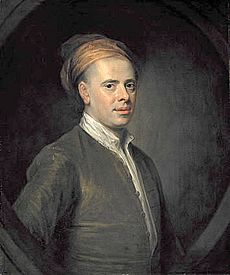
He also made pastoral poetry popular. This type of poetry describes country life. He helped develop a poetic form called the Habbie stanza, which Robert Burns later used. His Tea-Table Miscellany (1724–37) had old Scottish folk poems, his own poems in the folk style, and Scottish poems made to sound more like English. His pastoral opera The Gentle Shepherd was one of the most important works of the era. Ramsay also played a big part in supporting plays in Scotland and trying to create a permanent theatre in Edinburgh.
Poetry and Novels
Ramsay was part of a group of poets who wrote in both Scots and English. These included William Hamilton of Gilbertfield (around 1665–1751) and Alexander Ross (1699–1784). Also, the Jacobite poet William Hamilton of Bangour (1704–54), and the socialite Alison Rutherford Cockburn (1712–94). Poet and playwright James Thomson (1700–48) is most famous for his nature poems in Seasons.
Tobias Smollett (1721–71) was a poet, essay writer, and playwright. But he is best known for his adventure novels, like The Adventures of Roderick Random (1748) and The Adventures of Peregrine Pickle (1751). Because of these, he is often seen as Scotland's first novelist. His work greatly influenced later novelists like Thackeray and Dickens.
The early 1700s also saw new ideas in everyday Gaelic poetry. Important poets included Rob Donn Mackay (1714–78) and Donnchadh Bàn Mac an t-Saoir (Duncan Ban MacIntyre) (1724–1812). The most important figure was Alasdair mac Mhaighstir Alasdair (Alasdair MacDonald) (around 1698–1770). His interest in old forms can be seen in his most important poem Clanranald's Gallery. He also mixed these old traditions with influences from the Lowlands. This included Thomson's Seasons, which helped inspire a new kind of nature poetry in Gaelic. This new poetry didn't just focus on how nature related to people.
Drama in the 1700s
Scottish playwrights wrote plays in London. These included Catherine Trotter (1679–1749), who was born in London to Scottish parents and later moved to Aberdeen. Her plays included the sad play Fatal Friendship (1698) and the comedy Love at a Loss (1700). David Crawford's (1665–1726) plays included the comedies Courtship A-la-Mode (1700) and Love at First Sight (1704). These plays helped create the character of the "stage Scot," who was often funny but also clever and loyal.
Newburgh Hamilton (1691–1761), born in Ireland but of Scottish family, wrote the comedies The Petticoat-Ploter (1712) and The Doating Lovers (1715). He later wrote the words for Handel's opera Samson (1743). James Thomson's plays often dealt with the conflict between public duty and private feelings. These included Sophonisba (1730) and Agamemnon (1738). His play Tancrid and Sigismuda (1745) was a success around the world. David Mallet's (around 1705–65) Eurydice (1731) was thought to be a secret play supporting the Jacobites. His later work showed he was against the government at the time. The opera Masque of Alfred (1740) was a team effort between Thompson, Mallet, and the composer Thomas Arne. Thompson wrote the words for his most famous work, the patriotic song Rule, Britannia!
In Scotland, a group of English actors came to Edinburgh in 1715. They performed Macbeth and several comedies. But they soon left, perhaps because the local church leaders objected. By 1725, English actor Anthony Aston, a friend of Ramsay, was performing in Edinburgh. But he seemed to have trouble with the Scottish Master of the Revels, who approved plays and theatres. So he left soon after. In 1727, the Kirk attacked theatres, calling them immoral.
The Edinburgh Company of Players could perform in Dundee, Montrose, Aberdeen, and regularly at the Taylor's Hall in Edinburgh. They had protection from a Royal Patent. Ramsay helped them set up a small theatre in Carruber's Close in Edinburgh. But the 1737 Licensing Act made their activities illegal, and the theatre soon closed. A new theatre opened at Cannongate in 1747 and operated without a licence into the 1760s.


